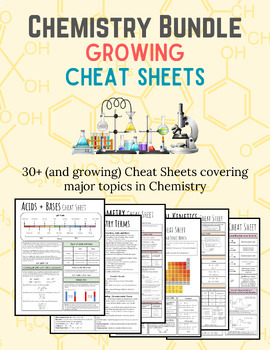CHEMISTRY BUNDLE || Cheat Sheets ONLY!
- Zip
Products in this Bundle (36)
showing 1-5 of 36 products
Also included in
- 40% savings on all Cheat Sheets and Chemistry Practice if purchased through the bundle. It includes 50 products (and growing!). As I continue to make more Cheat Sheets and Practice, I will add them in to this bundle and you will receive them for no additional charge if you have already purchased thiPrice $48.00Original Price $85.50Save $37.50
Description
Buy ASAP! Over 30% savings on all Cheat Sheets if purchased through the bundle (50% if you purchase the Year-Long Curriculum that includes Interactive Textbook Practices as well!). It includes over 30 products (and growing!). As I continue to make more Cheat Sheets, I will add them in to this bundle and you will receive them for no additional charge if you have already purchased this (otherwise the price increases slightly with each new Cheat sheet).
This Bundle includes the following:
Cheat Sheets:
- Chemistry Cheat Sheet / Study Guide / Reference: Common Chemistry Terms
- Chemistry Cheat Sheet / Study Guide / Reference: Units, Prefixes, and Constants
- Chemistry Cheat Sheet / Study Guide / Reference: States of Matter
- Chemistry Cheat Sheet / Study Guide / Reference: Phase Change Diagrams
- Chemistry Cheat Sheet / Study Guide / Reference: Reading Boxes on the Periodic Table
- Chemistry Cheat Sheet / Study Guide / Reference: Nonmetals, Metals, and Metalloids on the Periodic Table
- Chemistry Cheat Sheet / Study Guide / Reference: Periodic Trends
- Chemistry Cheat Sheet / Study Guide / Reference: Electron Configuration
- Chemistry Cheat Sheet / Study Guide / Reference: Drawing the Bohr Model
- Chemistry Cheat Sheet / Study Guide / Reference: Lewis Structures
- Chemistry Cheat Sheet / Study Guide / Reference: Determining Bond Types
- Chemistry Cheat Sheet / Study Guide / Reference: Drawing Simple Covalent Bonds
- Chemistry Cheat Sheet / Study Guide / Reference: Shapes of Molecules
- Chemistry Cheat Sheet / Study Guide / Reference: Gas Laws
- Chemistry Cheat Sheet / Study Guide / Reference: Chemical Reactions
- Chemistry Cheat Sheet / Study Guide / Reference: Naming Simple Compounds
- Chemistry Cheat Sheet / Study Guide / Reference: Acids + Bases
- Chemistry Cheat Sheet / Study Guide / Reference: Simple Organic Molecules
- Chemistry Cheat Sheet / Study Guide / Reference: Chemical Kinetics
- Chemistry Cheat Sheet / Study Guide / Reference: Stoichiometry
- Chemistry Cheat Sheet / Study Guide / Reference: Writing Ionic Compound Formulas
- Chemistry Cheat Sheet / Study Guide / Reference: Single / Double Replacement Reactions
- Chemistry Cheat Sheet / Study Guide / Reference: Intermolecular Forces
- Chemistry Cheat Sheet / Study Guide / Reference: Balancing Chemical Equations
- Chemistry Cheat Sheet / Study Guide / Reference: Chemical Equilibrium
- Chemistry Cheat Sheet / Study Guide / Reference: Electromagnetic Spectrum
- Chemistry Cheat Sheet / Study Guide / Reference: Evolution of the Atom
The Chemistry Cheat Sheet series provides students with condensed information about popular topics in Chemistry. They consist of flow charts, step-by-step procedures for different units, diagrams, and common definitions. They are an excellent resource for students to use while doing independent work or reviewing for quizzes and exams.
NGSS Standards
HS-PS1-1 Matter and its Interactions
Use the periodic table as a model to predict the relative properties of elements based on the patterns of electrons in the outermost energy level of atoms.
HS-PS1-2 Matter and its Interactions
Construct and revise an explanation for the outcome of a simple chemical reaction based on the outermost electron states of atoms, trends in the periodic table, and knowledge of the patterns of chemical properties.
HS-PS1-3 Matter and its Interactions
Plan and conduct an investigation to gather evidence to compare the structure of substances at the bulk scale to infer the strength of electrical forces between particles.



